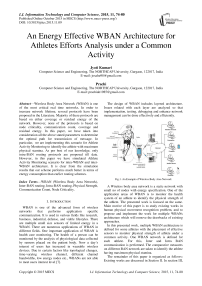An Energy Effective WBAN Architecture for Athletes Efforts Analysis under a Common Activity
Автор: Jyoti Kumari, Prachi
Журнал: International Journal of Information Technology and Computer Science(IJITCS) @ijitcs
Статья в выпуске: 11 Vol. 7, 2015 года.
Бесплатный доступ
Wireless Body Area Network (WBAN) is one of the most critical real time networks. In order to increase network lifetime, several protocols have been proposed in the Literature. Majority of these protocols are based on either coverage or residual energy of the network. However, none of the protocols is based on node criticality, communication count, coverage and residual energy. In this paper, we have taken into consideration all the above stated parameters to determine the optimal path for transmission of message. In particular, we are implementing this scenario for Athlete Activity Monitoring to identify the athlete with maximum physical stamina. As per best of our knowledge, only intra-BAN routing protocols are proposed till date. However, in this paper we have simulated Athlete Activity Monitoring scenario for intra-WBAN and inter-WBAN architecture. It is clear from the simulation results that our scheme performs much better in terms of energy consumption than earlier routing schemes.
WBAN (Wireless Body Area Network), Inter-BAN routing, Intra-BAN routing, Physical Strength, Communication Count, Node Criticality
Короткий адрес: https://sciup.org/15012403
IDR: 15012403
Список литературы An Energy Effective WBAN Architecture for Athletes Efforts Analysis under a Common Activity
- Kihyun Kim, "An Efficient Routing Protocol based on Position Information in Mobile Wireless Body Area Sensor Networks", 2009 First International Conference on Networks & Communications 978-0-7695-3924-9/09 © 2009 IEEE.
- Md. Tanvir ul Huque et al., "SEA-BAN: Semi -Autonomous Adaptive Routing in Wireless Body Area Networks", 7th International Conference on Signal Processing and Communication Systems, IEEE 2013, pp. 1-7
- Md. Tanvir ul Huque et al., "EAR-BAN: Energy Efficient Adaptive Routing in Wireless Body Area Networks", 7th International Conference on Signal Processing and Communication Systems, IEEE 2013, pp. 1-10.
- Arash Maskooki, "Opportunistic Routing for Body Area Network", 1st IEEE International Workshop on Consumer eHealth Platforms, Services and Applications 978-1-4244-8790-5/11 © 2011 IEEE.
- Shruti P. Mahambre, "Decentralized Adaptive Routing for Reliability in Event Broker Networks", 2009 15th International Conference on Parallel and Distributed Systems 1521-9097/09 © 2009 IEEE.
- N. Javaid, "Measuring Fatigue of Soldiers in Wireless Body Area Sensor Networks", 2013 Eighth International Conference on Broadband, Wireless Computing, Communication and Applications 978-0-7695-5093-0/13 © 2013 IEEE.
- Samaneh Movassaghi, "Wireless Body Area Networks: A Survey", IEEE Communications Surveys & Tutorials, 2013 IEEE, volume 16, pp. 1658-1686.
- Aravind Kailas, "Wireless Communications Technology in Telehealth Systems", 1st International Conference on Wireless Communication, Vehicular Technology, Information Theory and Aerospace & Electronics Systems Technology, VITAE 2009 IEEE, pp. 926-930.
- Xiaoling Wu, "Optimal Routing in Sensor Networks for In-home Health Monitoring with Multi-factor Considerations", Sixth Annual IEEE International Conference on Pervasive Computing and Communications 0-7695-3113-X/08 © 2008 IEEE.
- N. Javaid, "Measuring Fatigue of Soldiers in Wireless Body Area Sensor Networks", 8th International Conference on Broadband, Wireless Computing, Communication and Applications, 2013 IEEE, pp. 227-231.
- Ashay Dhamdhere.et.al, " Experiments with Wireless Sensor Networks for Real Time Health Monitoring", 35th Conference on Local Area Networks, IEEE 2010, pp. 938-945.
- Zongjian He .et.al, "A Wearable Wireless Body Area Network for Human Activity Recognition", 6th International Conference on Ubiquitous and Future Networks, 2014 IEEE, pp. 115-119.


